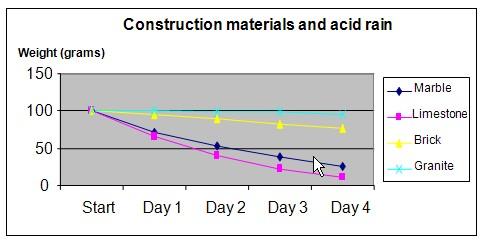| Complexity level: | 8 |
| Project cost ($): | 80 |
| Time required: | 1 hour to prepare, 4 days for the science project experiment |
| Material availability: | Easily found |
| Safety concerns: | Handle acids with care - ensure that you wear protective clothing/goggles/gloves. Adult supervision required. |
Hypothesis
Between marble, limestone, granite and bricks. limestone suffers the most damage from acid rain.
Overview
Acid rain
Acid rain is the rainfall that has turned acidic due to water vapor reacting with other pollutants like nitrogen and sulfur in our atmosphere. Acid rain not only poses a threat to the ecosystem and environment, but also causes serious damage to buildings and sculptures worldwide.
Limestone and marbles are very vulnerable to damage by acid rain. These two building materials contain calcite which easily dissolves in acid. Acid rain causes serious damage to concrete surfaces and paint finishes on building surfaces.
Most modern homes and buildings nowadays are made of materials resistant to acid rain. Even then, acid rain does not spare them. The steel rods used in manufacturing concrete blocks, corrode faster when exposed to acid rains. Bricks also start to crumble in acid rain. Bricks use a special fabric that helps to hold silica grains together. Acid rain dissolves this fabric easily causing the bricks to become weak and fragile and this eventually causes bricks walls to eventually collapse.
Scientific Terms
Materials
The materials required for the science fair project experiment:
- 100 grams of marble
- 100 grams of limestone
- 100 grams of brick
- 100 grams of granite
- 1 digital weighing scale
- 4 beakers
- 1600ml of vinegar
- 1 measuring cylinder
- 1 piece of cloth
- 1 sand paper
- hammer
- chisel
Procedure
1. For this science fair project, the independent variable is the type of construction material tested – marble, limestone, brick and granite. The dependent variable is the weight of the remaining construction material after a few days. This is determined by measuring the weight using a digital weighing scale. The constants (control variables) are the acidity of the vinegar solution, the amount of vinegar used, the initial weight of the construction material and the length of time the science experiment is conducted.
2. On the first day of the science fair project, the construction materials selected to be tested are marble, limestone, brick and granite. All 4 materials are cleaned and their weight checked to be ensure that they each weight exactly 100g. If the weight is over 100grams, the specimen’s weight is reduced using sand paper (or hammer and chisel, if necessary). The starting weights of the samples are recorded in the table given below.
3. The measuring cylinder is used to measure 400ml of vinegar and poured into each of the 4 beakers. The construction materials to be tested are placed into each of the beakers. The vinegar solution is used to simulate acid rain.
4. Every day for the next 4 days the specimens are removed from the beaker, wiped lightly with a piece of cloth and their weight is checked on the digital weighing scale and recorded in the table given below.

Results
It was observed that the limestone, followed by the marble, lost the most weight. The brick lost a moderate amount of weight and the granite dissolved the least.
|
Construction material |
The weight of the construction material immersed in vinegar(gram) |
||||
|
Start |
Day 1 |
Day 2 |
Day 3 |
Day 4 |
|
|
Marble |
100 |
72 |
53 |
39 |
26 |
|
Limestone |
100 |
65 |
41 |
22 |
11 |
|
Brick |
100 |
95 |
89 |
83 |
76 |
|
Granite |
100 |
100 |
99 |
98 |
96 |
The graph below represents the results of our science project experiment.

Conclusion
The hypothesis that limestone would see the greatest amount of damage from acid rain, is proven to be true.
Acid rain is a serious threat not only to plants and animals, but also to buildings, monuments, bridges and our very homes. Buildings and monuments that hold historical value are literally being dissolved and washed away by acid rain. Even modern buildings and bridges are not spared. Bridges made of steel are weakened due to corrosion caused by acid rain. The cost to major cities, for repairs necessitated by damage caused by acid rain, amounts to millions of dollars.
Also consider
This science fair project may be repeated, this time, with one set of specimens exposed to sunlight and the other set kept in a dark room.
Modify the science project experiment, using other construction materials like cement, steel, copper, etc.
References
How to affect acid rain in buildings? - http://worldacidrainsecrets.blogspot.com/2010/01/how-to-affect-acid-rain-in-buildings.html
How dies acid precipitation affect marble and limestone buildings? - http://pubs.usgs.gov/gip/acidrain/5.html

